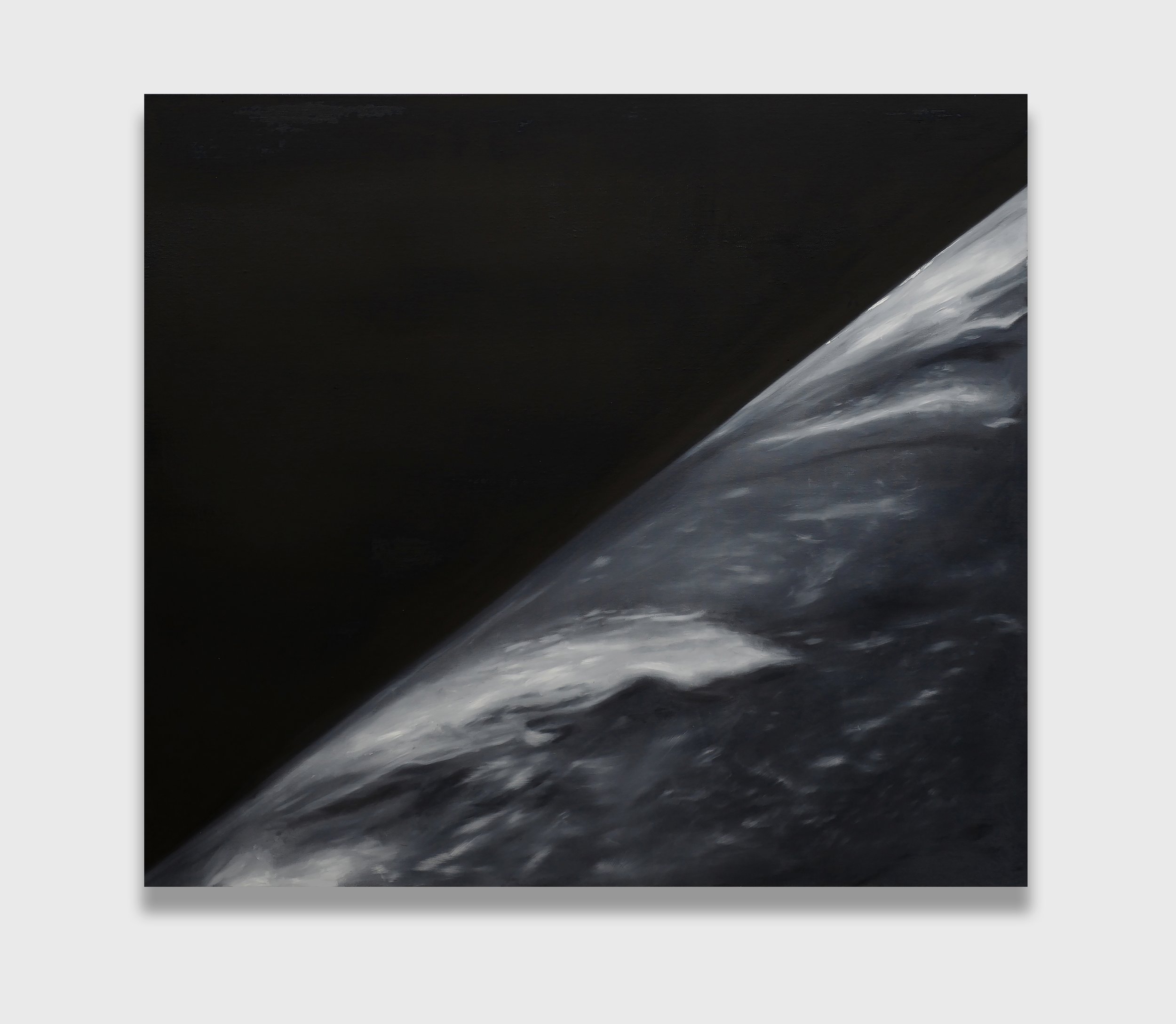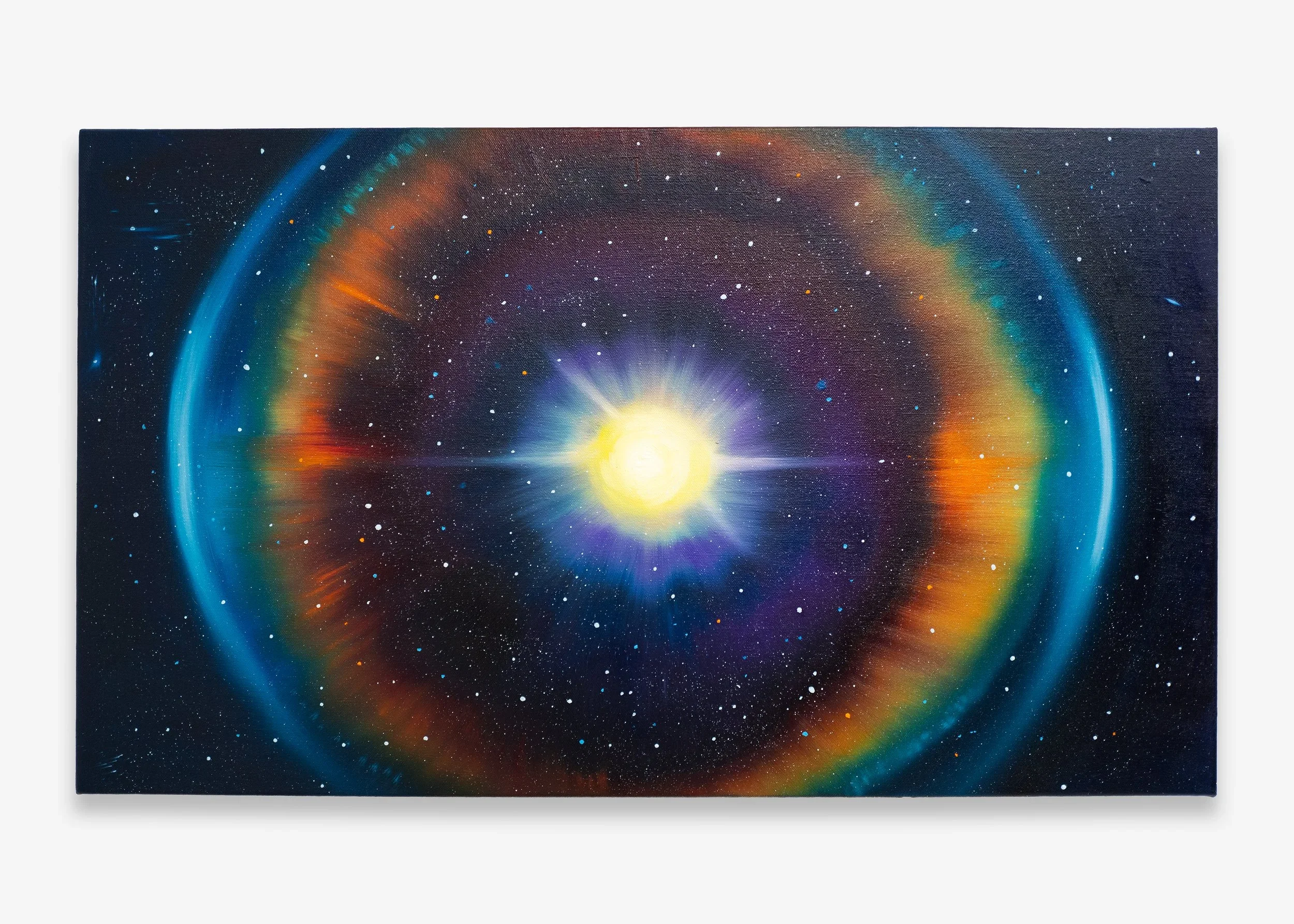Space

Gaze: Observable Infinity, 2024
Oil on linen
40 x 55 cm (16 x 22 in)
Gaze: Observable Infinity (2024), draws from the concept of the “observable universe,” transforming it into an immersive cosmic experience. At its heart, the painting features a radiant, circular light resembling an eye—a “cosmic iris”—as though the universe itself is gazing back at the viewer. This central focus is encircled by concentric rings of color, gradually fading into darkness, symbolizing both the visible and hidden realms of existence.
Through symbolic colors and abstract forms, Gaze: Observable Infinity transcends visual representation, guiding viewers into a meditative reflection on our shared existence and the unseen structures that connect us. The vast perspective of the cosmos merges with the intimate image of an eye or a halo of collective light, creating a resonance that evokes a hidden structure of information in the microcosmic and macrocosmic worlds. Tan Mu bridges the macrocosmic and the personal, serving as both a meditation on the macrocosm and an exploration of collective human consciousness.
Light emerges from the depths of unknown darkness, carrying hidden information through the flow of time, soon to be revealed—a moment of revelation that Observable Infinity documents. Blending science, spirituality, and collective memory, this painting embodies both reverence for the mysteries of the universe and a deep exploration of shared awareness and interconnectedness. It invites viewers to prompt reflection on our role within a larger, interconnected whole.

Stanford Torus, 2020
Oil on linen
91x 76 cm (36 x 30 in)
"Stanford Torus, 2020" intricately explores the visionary concept of the Stanford Torus space settlement, conceived during the 1975 NASA Summer Study in collaboration with Stanford University. This monumental design features a torus-shaped ring with a diameter of one mile, rotating to simulate Earth-normal gravity on its interior surface, capable of accommodating up to 10,000 residents. The artwork captures the grandeur and futuristic allure of this ambitious space colony concept, inviting viewers to immerse themselves in the intricacies of its architectural design—a testament to human ingenuity and imagination reaching beyond the confines of Earth. Rooted in the awe-inspiring realm of space exploration, the Stanford Torus symbolizes humanity's boundless curiosity and quest for innovation. It embodies our collective wonder towards the cosmos, where dreams of sustainable living and thriving communities in space come to life. The painting sparks contemplation on the technological advancements necessary for such ventures, as well as the ethical and philosophical dimensions of expanding human civilization beyond our planetary borders.

Horizons 02, 2024
Oil on linen
41 x 51 cm (16 x 20 in)
Horizons draws inspiration from the International Space Station, offering a transformative perspective on humanity and Earth. The series captures the radiant lights of megacities and the dreamlike reflections of Earth’s atmosphere, symbolizing the beauty of human civilization. These interwoven lights and shadows highlight the profound impact of technology on how we perceive the world. Tan Mu explores the potential of technology to expand visual boundaries, particularly through real-time transmissions from space that allow humanity to observe Earth from a cosmic vantage point. This “panoramic gaze,” enabled by technology, fosters collective awareness and redefines landscape art, offering a cosmic-scale reexamination of human existence. When the perspective rises above the horizon, a vast sense of peace emerges, inviting humanity to reimagine its place and potential within a connected world. Through layers of oil on linen, Tan Mu translates this cosmic perspective into a tangible visual language. The horizon becomes a dynamic interplay of color and form, evoking depth and expansiveness. Subtle shifts in tone and texture mirror the fluidity of time and space, capturing moments of transition—dawn, dusk, or the infinite calm of a still sea. At its heart, Horizons reflects Tan Mu’s fascination with universal structures and shared human experiences. It reminds us that in the immensity of the cosmos, our shared humanity is both fragile and profoundly connected.

Horizons 03, 2024
Oil on linen
46 x 61 cm (18 x 24 in)
Horizons draws inspiration from the International Space Station, offering a transformative perspective on humanity and Earth. The series captures the radiant lights of megacities and the dreamlike reflections of Earth’s atmosphere, symbolizing the beauty of human civilization. These interwoven lights and shadows highlight the profound impact of technology on how we perceive the world. Tan Mu explores the potential of technology to expand visual boundaries, particularly through real-time transmissions from space that allow humanity to observe Earth from a cosmic vantage point. This “panoramic gaze,” enabled by technology, fosters collective awareness and redefines landscape art, offering a cosmic-scale reexamination of human existence. When the perspective rises above the horizon, a vast sense of peace emerges, inviting humanity to reimagine its place and potential within a connected world. Through layers of oil on linen, Tan Mu translates this cosmic perspective into a tangible visual language. The horizon becomes a dynamic interplay of color and form, evoking depth and expansiveness. Subtle shifts in tone and texture mirror the fluidity of time and space, capturing moments of transition—dawn, dusk, or the infinite calm of a still sea. At its heart, Horizons reflects Tan Mu’s fascination with universal structures and shared human experiences. It reminds us that in the immensity of the cosmos, our shared humanity is both fragile and profoundly connected.

Dyson Sphere, 2023
Oil on linen
152 x 183 cm (60 x 72 in)
A Dyson sphere is a hypothetical megastructure that encircles a star, absorbing its energy output and providing an almost infinite source of energy for its inhabitants. The idea was first introduced by physicist Freeman Dyson in 1960 as a solution to the problem of the eventual depletion of Earth's energy resources. The sphere would consist of a series of solar panels or other energy-harvesting devices surrounding the star, capturing its energy output and providing nearly limitless energy for civilization. The construction of a Dyson sphere remains a purely theoretical idea, as it would require an almost incomprehensible amount of resources and technological advancements beyond our current capabilities. However, the concept remains a fascinating topic for discussion and exploration. Scientists have devised other methods of harnessing solar energy, such as solar panels on Earth or in space, to power our society.

Peek, 2021
Oil on linen
91 x 102 cm (36 x 40 in)
Peek (2021) is reminiscent of the first photographs taken from space. On October 24, 1946, the V-2 No. 13 rocket was launched at the White Sands Missile Range in White Sands, New Mexico, reaching a maximum altitude of 65 miles. This rocket was the first to capture a photograph of the Earth from space; every 1.5 seconds, photos were taken at a speed five times quicker than any previous camera. Peek explores the underlying motivation for humanity to explore space.

Powehi, 2022
Oil on linen
61 x 91 cm (24 x 36 in)
A black hole is an extremely dense object where no light can escape. Anything that comes within a black hole’s event horizon — its point of no return, will be consumed, never to reemerge, because of the black hole’s unimaginably strong force of gravity. A black hole cannot be seen by nature, but the hot disk of material that encircles it shines bright. Against a bright backdrop, such as this disk, a black hole appears to cast a shadow. It was at this moment that humankind was able to capture the first image of one.
In April 2019, using the Event Horizon Telescope, scientists obtained an image of Powehi, a black hole at the center of galaxy Messier 87 (M87). The M87 is an elliptical galaxy around 55 million light-years from Earth, and the black hole is 6.5 billion times the mass of the Sun. Catching its shadow involved eight ground-based radio telescopes around the globe, operating together and acting as one telescope. The image was named Powehi, translated from an 18thcentury Hawaiian chant as “embellished dark source of unending creation.”.

Sagittarius A*, 2022
Oil on linen
61 x 91 cm (24 x 36 in)
"Sagittarius A*, 2022" is inspired by the groundbreaking scientific achievement of capturing the first image of the Milky Way galaxy's black hole. This work commemorates not only the celestial subject itself but also the remarkable global collaboration among scientists that made the visualization possible.
Sourcing from the first image of Sagittarius A*, the supermassive black hole at the center of our galaxy, this painting interprets the intricate dance of light and gravity, shadows and illumination that define such cosmic phenomena.
More than a depiction of a distant astronomical object, "Sagittarius A*, 2022" highlights the human spirit of cooperation and the collective pursuit of knowledge. It celebrates the coordinated efforts of scientists across different continents who, through a network of telescopes, managed to synthesize data to reveal a part of our universe never seen before. This artwork serves as a testament to the power of human collaboration and the boundless curiosity that drives us to explore not just the vastness of space but also the potential of our united endeavors.

Torus, 2020
Oil on linen
46 x 61 cm (18 x 24 inches)
Every atom on this planet is surrounded by the torus, which is a field of energy. A self-sustaining, dynamic energy flow system, consisting of two vortices and a single axis, is the foundation for everything powerful on earth. As energy passes through one vortex, it travels along the axis, out the other, wraps around the circumference, and then passes through the original vortex to be regenerated. Several of nature's most powerful creations possess this shape, including tornadoes, whirlpools, black holes, magnetic fields, and the energy fields that surround planets and the sun. It is found in all living organisms, including humans and plants. Our planet's atmosphere is created by the Earth's Torus, which runs through its center.

Torus, 2021
Oil on linen
61 x 46 cm (24 x 18 in)
Every atom on this planet is surrounded by the torus, which is a field of energy. A self-sustaining, dynamic energy flow system, consisting of two vortices and a single axis, is the foundation for everything powerful on earth. As energy passes through one vortex, it travels along the axis, out the other, wraps around the circumference, and then passes through the original vortex to be regenerated. Several of nature's most powerful creations possess this shape, including tornadoes, whirlpools, black holes, magnetic fields, and the energy fields that surround planets and the sun. It is found in all living organisms, including humans and plants. Our planet's atmosphere is created by the Earth's Torus, which runs through its center.

Moldavite, 2020
Oil on linen
36 x 28 cm (14 x 11 in)
As a meteorite impact occurred about 15 million years ago, local meteorites formed the Moldavite (Czech: vltavin), a green or olive green, or bluish-green projectile rock formed as a result of the impact of a meteorite in southern Germany (Nördlinger Ries Crater). It is a type of tektite. When we ponder the vastness of the universe, Moldavite (2020) reminds us of how small we are when we compare it to the universe's scope.








